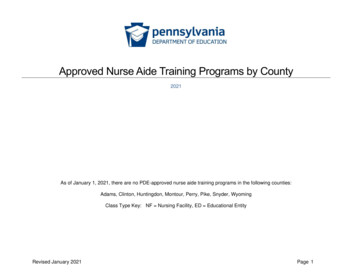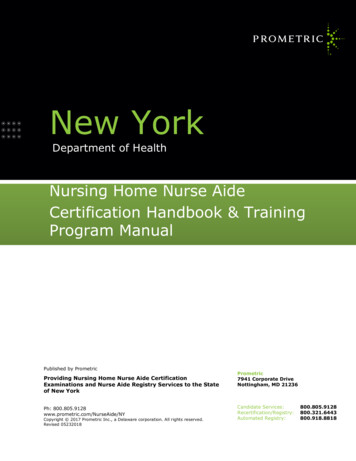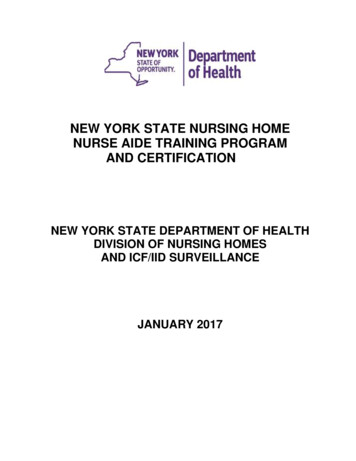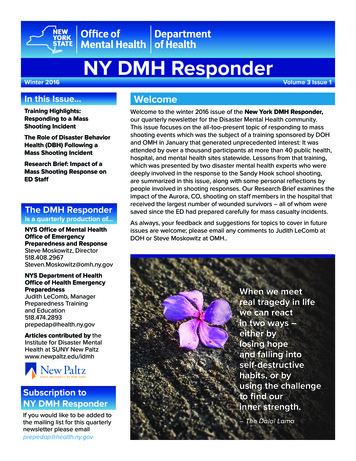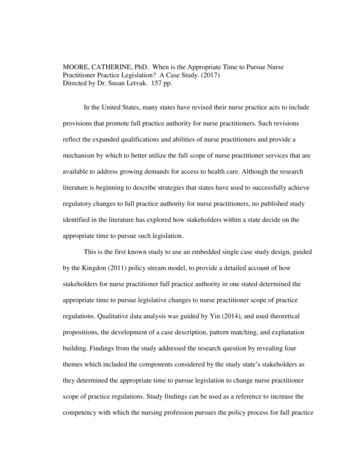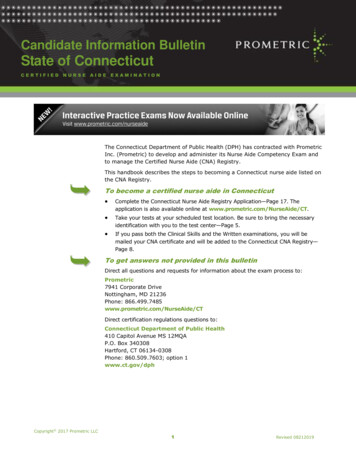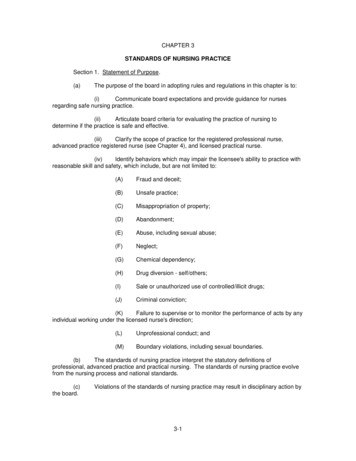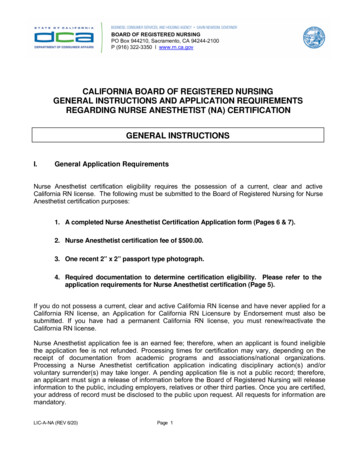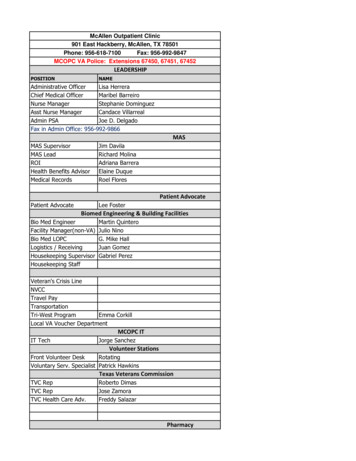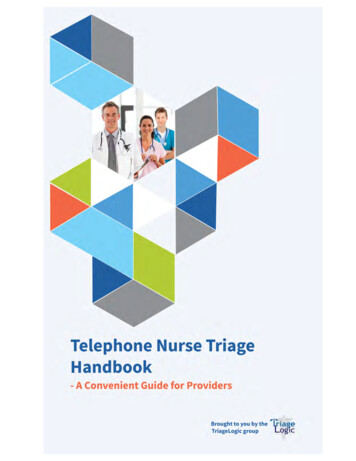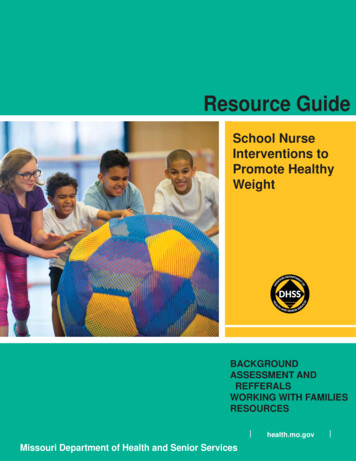
Transcription
Resource GuideSchool NurseInterventions toPromote HealthyWeightBACKGROUNDASSESSMENT ANDREFFERALSWORKING WITH FAMILIESRESOURCEShealth.mo.govMissouri Department of Health and Senior Services
AcknowledgmentsAdapted from Childhood Obesity: School Nurse ToolkitDeveloped by Rebecca Cartmill, MSN, RNUniversity of Missouri School of Nursing Capstone ProjectApril 2014School Nurse Toolkit: Student Overweight/ObesityIowa Department of Public HealthBureau of Nutrition and Health PromotionNutrition and Physical Activity ProgramFall 2011This resource manual was reviewed and revised based on valuable input from the following Missouri school nurses:Debra Cook, RN, Kennett School DistrictKatherine Park, MSN, RN, Parkway School DistrictBarbara Brommelhorst, MSN, RN, Wentzville School DistrictDianne Herndon, RN, RetiredPatti Kamp, RN, Meadow Heights School DistrictPriscilla Dickerson, RN, Mt Vernon School DistrictPat Sturges, BSN, RN, Sedalia School DistrictFurther input and recommendations were received from Ellen Barnidge, PhD, MPH, Saint Louis University andConstance Brooks, PhD, PMHCNS-BC, PHCNS-BC, Retired University of Missouri–Columbia.Reviewers and Advisors: Stacey White MSN, RN, and her sons Dallas White, Jack White and Austin WhiteJune 2015Missouri Department of Health and Senior ServicesBureau of Community Health and Wellnesshealth.mo.gov/schoolhealthAN EQUAL OPPORTUNITY/AFFIRMATIVE ACTION EMPLOYERServices provided on a nondiscriminatory basis.School Nurse Interventions for Childhood Obesity2
TABLE OF CONTENTSINTRODUCTION4SECTION 1: BACKGROUNDChildhood Obesity FactsHealth Effects of Childhood ObesityDefinitions of Overweight and ObesityRisk FactorsPrevention555667SECTION 2: ASSESSMENT AND REFERRALAssessmentProtocols to Assure PrivacyNurse/Student ConferenceReferralOpportunities for Prevention888910SECTION 3: WORKING WITH STUDENTS AND FAMILIESMotivational InterviewingSelf-ReflectionMotivational Interviewing PrinciplesSigns of Readiness and Key QuestionsMotivational Interviewing AlgorithmsTypes of InterviewsSample Dialogue of a Brief Negotiation for Weight ManagementMeasuring Progress121212131617192123SECTION 4: RESOURCESExample BMI Percentile Chart for Boys 2-20 Years of AgeExample BMI Percentile Chart for Girls 2-20 Years of AgeExample of Plotting BMI on Percentile ChartScreening Tool Blood Pressure Values Requiring Further EvaluationHealthy Lifestyle QuestionnaireSample Lifestyle QuestionsExample of Weight Management Intervention PlanPediatric Weight Management Tips for Getting StartedPromoting Healthy Eating for Children and AdolescentsPromoting Physical Activity in Children and AdolescentsSample Individualized Health Plan (IHP)Internet Resources for School Nurses Addressing Overweight and l Nurse Interventions for Childhood Obesity3
INTRODUCTIONAccording to the World Health Organization (WHO, 2012), childhood obesity is one of the mostsignificant health problems of the 21st century. The dramatic rise of childhood obesity and theserious health consequences associated with it cannot be overemphasized. Healthy People 2020has identified nutrition and weight status as topic areas of concern and developed specific goalsaimed at reducing the number of children and adolescents who are obese (U.S. Department ofHealth and Human Services [USDHHS], 2011).The Healthy People documents, issued in ten-year increments, are considered to be blueprints foraddressing the nation’s health. The documents identify the most pressing health concerns for thecoming decade and identify strategies to address them. Many are problems that can be addressedthrough early interventions in school settings. More than 95 percent of our children are enrolledin schools and are spending up to 13 years of their lives there. Schools and school nurses are in akey position to address this issue and advocate for children and adolescents who are, or are atrisk, of becoming obese.This resource kit will: Identify tools for assessment of the child and the school environment. Provide resources for the school nurse to educate and advocate for students who areoverweight or obese. Identify resources to promote healthy diet and physical activity habits in all children.The school nurse can use this guide as a resource when looking for ways to assist students, whoare overweight or obese, and their parents. School staff can be educated regarding their role inpromoting healthy eating habits and increasing the level of physical activity in the school setting.School Nurse Interventions for Childhood Obesity4
SECTION 1: BACKGROUNDCHILDHOOD OBESITY FACTSObesity is now the number one health concern among parents in the United States; it is moreconcerning to them than smoking or drug abuse.1 More than 12 million American children andadolescents (16.9 percent) are obese; and more than 23 million are either obese or overweight(31.8 percent).2 Overall, childhood obesity rates have tripled in the past 30 years. Based on 20112012 national data; 8.4 percent of 2-5 year olds, 17.7 percent of 6-11 year olds and 20.5 percentof 12-19 year olds were obese.While the national statistics are staggering, Missouri rates are equally alarming with 28 percentof 10-17 year olds being overweight or obese.3 Furthermore, the most at-risk for disease anddisparity, Missouri’s low income 2-5 year olds, have a 12.9 percent rate of obesity.4 Researchstudies have consistently demonstrated that youth who are overweight or obese havesubstantially higher odds of remaining obese in adulthood. This sets up a potential lifetime ofdisease, diminished quality of life and disability; therefore, reversing this trend with effectiveobesity prevention strategies and evidence-based treatment services is critical to the health of ourchildren.HEALTH EFFECTS OF CHILDHOOD OBESITYChildhood obesity has both immediate and long-term effects on health and well-being.Immediate health effects include higher likelihood of having: High blood pressure and high cholesterol, which are risk factors for cardiovasculardisease. Seventy percent of obese youth had at least one risk factor for cardiovasculardisease. Pre-diabetes or a high risk for development of diabetes. Bone and joint problems. Breathing problems such as asthma and sleep apnea. Fatty liver disease, gallstones and gastro-esophageal reflux. Social and psychological problems.Long-term health effects include: More severe obesity as an adult if overweight as a child. Higher likelihood of having adult health problems such as heart disease, type 2diabetes, stroke and osteoarthritis. Higher risk of being diagnosed with cancer, such as multiple myeloma and Hodgkin’slymphoma.Source: hool Nurse Interventions for Childhood Obesity5
DEFINITION OF OVERWEIGHT AND OBESITYBody mass index (BMI) is a measure used to determine childhood overweight and obesity. It iscalculated using a child's weight and height. BMI does not measure body fat directly, but it is areasonable indicator of body fatness for most children and teens.A child's weight status is determined using an age- and sex-specific percentile for BMI ratherthan the BMI categories used for adults, because children's body composition varies as they ageand varies between boys and girls. Centers for Disease Control and Prevention (CDC) GrowthCharts are used to determine the corresponding BMI for age and sex percentile.For children and adolescents (2-19 years of age): Overweight is defined as a BMI at or above the 85th percentile and lower than the95th percentile for children of the same age and sex. Obesity is defined as a BMI at or above the 95th percentile for children of the sameage and sex.Samples of the growth charts are included in the resource section.RISK FACTORSChildhood obesity is the result of eating too many calories and not getting enough physicalactivity. Many factors contribute to overweight/obesity; however, environmental factors andsocietal norms have made it difficult for most Missourians to practice behaviors that support ahealthy weight. This section lists some of the potential factors that influence weight. Childhood Lifestyle Factorso Not breastfed as an infant or weaned early on in the first year of life.o High intake of sugary drinks and other energy dense foods.o Low fruit and vegetable consumption.o More time spent on sedentary activities such as watching television, playingvideo games and using interactive hand-held devices. Family Influences and Parental Modelingo Children with two obese parents are 10 times more likely to become overweightthan children with no obese parents.o Prenatal environment, e.g. mother had gestational diabetes during pregnancy.o No/limited parental role modeling of a healthy diet and physically active lifestyle.o Lack of limits for screen time.o Lack of parenting behaviors that support a healthy weight, such as assuringadequate sleep.o Frequent meals eaten out where portions are often “super-sized.”School Nurse Interventions for Childhood Obesity6
Community Influenceso Poor access to affordable healthy foods, especially fruits and vegetables.o School and child care environments that do not support healthy eating andphysical activity.o Limited access to parks or sidewalks for walking, bike riding, and other activeplay.o Unsafe neighborhoods that limit opportunity for outdoor physical activity.o Targeted marketing of foods high in sugar, fat and salt.o Increased portion sizes of less healthy foods and beverages.PREVENTIONThe easiest way to manage obesity is to prevent it from happening in the first place. It isimportant for all children to hear prevention messages and experience environments that supporthealthy behaviors. Dietary and physical activity behaviors are influenced by medical careproviders, faith-based institutions, government agencies, the media; and food, beverage andentertainment industries. However, schools play a particularly critical role by establishing a safeand supportive environment with policies and practices that support healthy behaviors andopportunities to learn about and practice healthy eating and physical activity.Source: Centers for Disease Control and Prevention (CDC), 2014School Nurse Interventions for Childhood Obesity7
SECTION 2: ASSESSMENT AND REFERRALThere should be an assessment of weight status for every child entering the school system. Thedata may come from on-site measurement or reported from a health care provider. The BMIshould be tracked using the appropriate body mass index-for-age and sex growth charts whichcan be found at: http://www.cdc.gov/growthcharts/charts.htm#Set1. Sample growth charts arealso included on page 24 in the resource section. Students’ growth screening results are part ofthe health record and, should only be discussed with the student, their parent/guardian and healthcare providers with parent permission.The American Academy of Pediatrics recommends a yearly BMI screening for children 2 yearsof age and older, in conjunction with, a yearly physical exam with their private provider. Theydo not recommend these screenings at school due to limited resources to address the issue. Ifstudents are weighed and measured at school, the school nurse must have the time and resourcesto track and follow up on students whose BMI falls outside the norms for age and sex.PROTOCALS TO ASSURE PRIVACYThe school nurse and other personnel engaged in assessing student weight must recognize thesensitive nature of the assessment, both to the student and his/her parent. Parents/guardiansshould be given prior notification of the assessment and the opportunity to decline theassessment. The notification should describe the purpose of the assessment (i.e., for surveillance[collecting aggregate data to demonstrate a problem] or for assessing individual health status). Itshould also assure parents/guardians that the assessment will be done in a private setting and thatthe data collected will be handled in a confidential manner. See sample parent letter in GrowthScreening Guidelines, Missouri DHSS, 2005 at the link below.When assessing BMI, the screener must ensure: Equipment has been properly maintained and calibrated. Adequate time is allowed for the screening. The assessment is done in a private setting. Confidentiality is assured in terms of sight and sound. Students are weighed and measured facing away from the scales to reduce anxiety. A standard procedure* is followed, with each student being weighed and measuredtwice to ensure accuracy. Results are written down before the student steps away from the measuring device toreduce errors in transcription. Recording measurements incorrectly is a common errorthat occurs in assessment of height and weight. Recording the information on paperensures no one else hears the measurement.*Procedure outlined in Growth Screening Guidelines, Missouri Department of Health and SeniorServices, 2005, pdf/GuidelinesForGrowth.pdfSchool Nurse Interventions for Childhood Obesity8
Following the assessment of height and weight, the nurse should calculate the student’s BMIusing one of a variety of tools available (e.g., http://nccd.cdc.gov/dnpabmi/Calculator.aspx). TheBMI and BMI percentile for age and sex should be recorded in the health record. BMI is only ascreening tool, not a diagnostic tool. A child may have a high BMI for age and gender, but todetermine if overweight is a problem, other assessments need to be performed. Theseassessments may include skin-fold thickness measurement, diet and physical activity evaluation,and family history.NURSE/STUDENT CONFERENCESome students may wish to discuss their screening results with the school nurse. This discussionshould be done in a space that respects the student’s privacy. As part of the assessment, thestudent’s nutritional status, eating habits and physical activity patterns should be routinelyevaluated; along with identifying risk factors for overweight/obesity within the family. It isimportant to ask open-ended questions. The section on motivational interviewing may be helpfulin structuring this discussion. A question to open the discussion might be:“How do you feel about us discussing your physical activity, television watching andeating habits today?”Next, follow up with more focused questions addressing both physical activity and eating habits.Some questions to consider include:Physical Activity Questions How many hours of television do you watch each day? How many hours do you spend playing video games each day? How often do you play outside? Is it safe to do so? How often does your family do something active together? What might thatinclude? How often does your parent play actively with you?Nutrition Questions What does your family eat in a typical day? Do you have breakfast? What do you usually eat for breakfast? When eating at home, does your family routinely eat while watching thetelevision? How often does your family eat out each week? How often are fruits and vegetables served as part of your meals? What do you eat for snacks? How many sodas or sugary drinks do you drink each day?See page 28 in the resource section for a simple, lifestyle questionnaire.School Nurse Interventions for Childhood Obesity9
REFERRALWith a baseline BMI, the nurse can determine if the child’s weight status is changing. A changein percentile may signal a developing problem and may warrant a referral to a health careprovider for a medical evaluation that may include laboratory tests to identify any co-morbidconditions. The following students are candidates for a medical referral: Student with a BMI 85 percent, with at least one of the following factors–familyhistory of overweight/obesity, elevated blood pressure for age, or a large increase inBMI.Student with a BMI 95 percent.Student with a rapid increase in BMI.OPPORTUNITIES FOR PREVENTIONIt is helpful to structure the screening environment to communicate preventive care messagesthat focus on habits that support a healthy weight. This may include:Waiting Area Display posters with positive nutrition and physical activity messages that reinforcethe messages given during the assessment and private consultation. Posters are mosteffective when placed in areas where screening results will not be shared and placedat eye level of the intended reader. Display materials that address a variety of different health topics and referralresources. Materials might include:o Recipes for healthy foods.o A list of programs for overweight children.o Handouts focused on healthy eating and physical activity.o Tip sheets for families wanting to be more involved in their child’s diet andactivity choices.o A list of community sports and physical activity programs. Consider having chairs without arms that can support a child, adolescent or familymember of larger size or heavier weight.School Nurse’s OfficeEvery visit to the school nurse is an opportunity to convey health messages. Consider: Creating themed rooms if multiple rooms are available. For example make a “healthyeating room” and a “physical activity room” with appropriate materials displayed ineach. Having handouts for students on key preventive health topics to provide at the end ofeach visit and to send home to share with parents. Having armless chairs for students/parents who are a larger size or heavier weight.School Nurse Interventions for Childhood Obesity10
General School EnvironmentThe school environment should reflect the preventive health messages being provided duringassessments and school nurse counseling visits. Some of these opportunities include: Modeling of healthy weight, healthy eating and physical activity by all school staff. Avoiding the use of food as a reward. Stocking vending machines with water, 100% fruit juices and other healthy snacks. Demonstrating a personal commitment to maintaining a healthy weight. Take time towalk at school or wear a pedometer in the office; meet students for a weekly walk aspart of a “Walk with Your School Nurse” program. Encouraging physical activity in the classroom and during recess.See page 24 in the resource section for information on materials and websites for programsrelated to healthy eating, physical activity and staff wellness.School Nurse Interventions for Childhood Obesity11
SECTION 3: WORKING WITH STUDENTS AND FAMILIESThis section provides different resources and tools for working on behavior change with families.MOTIVATIONAL INTERVIEWINGOverweight and obesity are difficult and sensitive topics to address, especially with children.Parents often become defensive when family nutrition and physical activity patterns arediscussed as these patterns may apply to the whole family. Parents may feel their parenting skillsare being judged or criticized. Living conditions, unsafe neighborhoods and a lack of resourcesare often beyond a parent’s control. Discussing such a sensitive topic requires a non-judgmental,non-threatening approach and a willingness to take it a step at a time until the student and parentare willing to participate in the discussion. Motivational interviewing is one tool to address thisissue. The section on motivational interviewing will provide further information about how touse this technique when talking with parents and students. It is important to maintain sensitivityregarding overweight/obesity. Terms to consider:Instead ofObesityIdeal weightPersonal improvementFocus on weightDiets of “bad foods”ExerciseConsiderOverweightHealthier weightFamily progressFocus on lifestyleHealthier food choicesPhysical activitySELF-REFLECTIONThe authors of Motivational Interviewing: Helping People Change, Miller and Rollnick, 2013,emphasize compassion for clients and families to assure that healthcare providers activelypromote the welfare of others and make the needs of others a priority.An exercise that can help move one to a compassionate viewpoint is to engage in self-reflectionand reflection on what life might be like for others (personal communication, August 14, 2014,Brooks, C.W.). A quick moment of reflection can help to shift the mindset to add a component ofcompassion to the encounter. School nurses can do this by asking these questions: What are my first thoughts when I see someone who is overweight? What, if any, judgments do I make about people who are overweight? If I were an overweight child, how would I feel when I woke up in the morning to getready for school? What fears would I have about going to school? What am I (as the child) thinking about myself? Imagine you are the parent–what goes through your mind if you put yourself in theparent’s place? How do you feel about your child’s weight? Do you know how yourchild thinks/feels about his/her weight?School Nurse Interventions for Childhood Obesity12
MOTIVATIONAL INTERVIEWING PRINCIPLESMotivational interviewing provides a foundation for assisting individuals with developing therationale for making a lifestyle change. This resource provides basic information forcommunicating using motivational interviewing. Motivational interviewing is an “empathic,person-centered counseling approach that prepares people for change by helping them resolveambivalence, enhance intrinsic motivation and build confidence to change.” (Kraybill andMorrison, 2007) Open questions, affirmation, reflective listening and summary reflections(OARS) are the basic interaction techniques and skills that are used “early and often” in themotivational interviewing approach. The table below provides an explanation and givesexamples for each step of the motivational interviewing en questions invite others to “telltheir story” in their own wordswithout leading them in a specificdirection. Open questions should beused often in conversation, but notexclusively. When asking openquestions, you must be willing tolisten to the person’s response.Open questions are the opposite ofclosed questions. Closed questionstypically elicit a limited responsesuch as “yes” or “no.” The followingexample contrasts open vs. closedquestions. Note how the topic is thesame, but the response will be verydifferent: Did you have a good relationshipwith your parents? What can you tell me about yourrelationship with your parents?Affirmations are statements andgestures that recognize clientstrengths and acknowledge behaviorsthat lead in the direction of positivechange, no matter how big or small.Affirmations build confidence inone’s ability to change. To beeffective, affirmations must begenuine and congruent.School Nurse Interventions for Childhood ObesityExamplesExamples of open questions: How can I help you with ? Help me understand ? How would you like things to bedifferent? What are the good things about andwhat are the bad things about it? When would you be most likely to ? What do you think you will lose if yougive up ? What have you tried before to make achange? What do you want to do next?Examples of affirming responses: I appreciate that you are willing to meetwith me today. You are clearly a very resourcefulperson. You handled yourself really well in thatsituation. That’s a good suggestion. If I were in your shoes, I don’t know ifI could have managed nearly so well. I’ve enjoyed talking with you today.13
ReflectiveListeningSummariesReflective listening is the pathway forengaging others in relationships,building trust and fostering motivationto change. Reflective listening appearseasy, but it takes hard work and skill todo it well. Sometimes the “skills” weuse in working with clients do notexemplify reflective listening, butinstead serve as roadblocks to effectivecommunication. Examples aremisinterpreting what is said orassuming what a person needs.It is vital to learn to think reflectively.This is a way of thinking thataccompanies good reflective listening.It includes interest in what the personhas to say and respect for the person’sinner wisdom. Listening breakdownsoccur in any of three places: Speaker does not say what ismeant. Listener does not hear correctly. Listener gives a differentinterpretation to what the wordsmean.Reflective listening is meant to closethe loop in communication to ensurebreakdowns don’t occur. The listener’svoice turns down at the end of areflective listening statement. This mayfeel presumptuous, yet it leads toclarification and greater exploration;whereas questions tend to interrupt theclient’s flow.Summaries are special applications ofreflective listening. They can be usedthroughout a conversation but areparticularly helpful at transition points,for example, after the person hasspoken about a particular topic, hasrecounted a personal experience, orwhen the encounter is nearing an end.Summarizing helps to ensure there isclear communication between thespeaker and listener.School Nurse Interventions for Childhood ObesityHelpful phrases for reflective listening: So you feel It sounds like you You’re wondering if There are three basic levels of reflectivelistening that may deepen or increase theintimacy and thereby change the affectivetone of an interaction. In general, the depthshould match the situation. Examples ofthe three levels include: Repeating or rephrasing: Listenerrepeats or substitutes synonyms orphrases, and stays close to what thespeaker has said. Paraphrasing: Listener makes arestatement in which the speaker’smeaning is inferred. Reflection of feeling: Listeneremphasizes emotional aspects ofcommunication through feelingstatements. This is the deepest form oflistening.Varying the levels of reflection is effectivein listening. Also, at times there arebenefits to over-stating or under-stating areflection. An over-stated reflection maycause a person to back away from theirposition or belief. An under-statedreflection may help a person to explore adeeper commitment to the position orbelief.Structure of Summaries1. Begin with a statement indicating youare making a summary. For example: Let me see if I understand so far Here is what I’ve heard. Tell me ifI’ve missed anything.2. Give special attention to “ChangeStatements.” These are statementsmade by the client that point toward awillingness to change. Miller andRollnick (2002) have identified four14
Summariescont.Also, it can provide a stepping stonetoward change.3.4.5.6.7.types of change statements, all ofwhich overlap significantly: Problem recognition: “My usehas gotten a little out of hand attimes.” Concern: “If I don’t stop,something bad is going to happen.” Intent to change: “I’m going to dosomething; I’m just not sure whatit is yet.” Optimism: “I know I can get ahandle on this problem.”If the person expresses ambivalence,it is useful to include both sides in thesummary statement. For example:“On the one hand , on the otherhand ”It can be useful to include informationin summary statements from othersources (e.g., your own clinicalknowledge, research, courts orfamily).Be concise.End with an invitation. For example: Did I miss anything? If that’s accurate, what other pointsare there to consider? Anything you want to add orcorrect?The client’s response to yoursummary statement may leadnaturally to planning for or takingconcrete steps toward the change goal.Source: Adapted from handouts by David Rosengren and from Miller & Rollnick, MotivationalInterviewing, 2nd Edition. 2002. Motivational Interviewing: Open Questions, Affirmation,Reflective Listening, and Summary Reflections (OARS). Retrieved x?id 32840&g printtopic&t 427School Nurse Interventions for Childhood Obesity15
SIGNS OF READINESS AND KEY QUESTIONSDetermining a student’s readiness for change is essential for success. Discussing changes when astudent is not ready often leads to resistance, denial of problems or frustration that may hamperfuture efforts. The following tool provides a basis for starting a discussion with students andparents.Ask the child how ready he/she is to make a change, on a scale of 1 to 10, with 0 being notinterested, and 10 being very ready to try to change. Using the questions below; probe forfurther information about readiness.0-3 Not readyRaise awarenessElicit change talkAdvise and encourage4-6 UnsureEvaluate ambivalenceElicit change talkBuild readiness7-10 Ready for ChangeStrengthen commitmentElicit change talkFacilitate action planningKey QuestionWould you be interested in knowing more about reaching ahealthy weight?How can I help?What might need to be different for you to consider achange in the future?Key QuestionWhere does that leave you now?What do you see as your next steps?What are you thinking/feeling at this point?Where does this fit in your future?Key QuestionWhy is this important to you now?What are your ideas for making this work?What might get in the way? How might you work aroundthese barriers? How might you reward yourself along theway?It helps to have a visual aid like this scale for the student to look at while considering his level ofreadiness:012345School Nurse Interventions for Childhood Obesity67891016
MOTIVATIONAL INTERVIEWING ALGORITHMSMOTIVATIONAL INTERVIEWING FOR THE PRE-CONTEMPLATION STAGE OF CHANGEExplore the pros and cons of current behavior toraise student awareness.ProsConsWhat are the positive things about .?What are the negative things about ?What do you think is the up side of .?Assess readiness for changeHow ready are you to .?Ask “might” questions.Do you think you might consider ?If student is ready for change If student is not ready for change Establish a time frame:When might you want to begin ?Let it go for now. Be available andprepared to repeat the process.School Nurse Interventions for Childhood Obesity17
MOTIVATIONAL INTERVIEWING FOR CONTEMPLATION STAGE OF CHANGEExplore the pros and cons of the new alternati
reasonable indicator of body fatness for most children and teens. A child's weight status is determined using an age- and sex-specific percentile for BMI rather than the BMI categories used for adults, because children's body composition varies as they age and varies between boys and girls. Centers for Disease Control and Prevention (CDC) Growth
